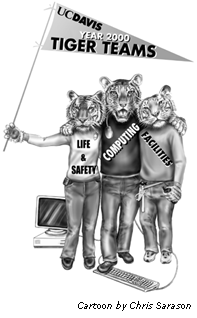 | |
 |
by Donna Justice
Starting in the summer of 1997 UC Davis began to analyze the potential areas and computing systems which might experience Year 2000 problems. At the end of 1998, a campuswide Y2K Program Office was created to handle the coordination of information, awareness building, and reporting to the campus and the UC Office of the President. During the last year, departments and major critical systems finished testing and remediating Y2K-related problems. "We were extremely cautious in approaching the Year 2000 problem," says Gorham. "We knew technically what it was and how to solve it. The problem was going systematically through each application, module, database, and embedded system and examining it. Because we did this across the board, we were able to address all the issues. Had we not done this, we would have been in a completely different boat."
On December 28, the Year 2000 Program Office moved into the UC Davis Fire Station and provided extended support hours through January 3, including being staffed from 3 a.m. on December 31 to 5 p.m. on January 1. During the rollover, the Network Operations Center slightly increased monitoring for security breaches on UC Davis' network, with no problems reported. "We were monitoring the network carefully and everything was great," said Kevin Rhodes, Manager of the Network Operations Center. Technical staff tested systems thoroughly on January 2 and 3 and found only minor glitches, such as inaccurate times on computer clocks. The result of all these efforts was that the campus suffered virtually no reported Y2K incidents. "All the preparation for Y2K was well worth it," says John Bruno, Vice Provost, Information and Educational Technology. "The whole team did an exemplary job for which we should all be grateful."
The campus, through the UC Davis Site License Coordinator (see http://slc.ucdavis.edu/), has arranged a special deal with Symantec, a software company, to license the latest version of Norton Anti-Virus. All campus affiliates can purchase a CD for a mere $3.50 plus tax at the Computer Shop in the UC Davis Bookstore. For those who have installed Bovine Online, the IT-created Internet software package, Norton Anti-Virus is already included. Once installed, Norton offers a Live Update feature which allows you to regularly access Symantec's storehouse of virus fixes and updates on the Web. It also allows you to set up a schedule for future updates. Make sure to connect to the Internet during those times. Users entering data into spreadsheets and databases must also continue to be vigilant. Entering two digit dates, even into compliant software, can still create Y2K errors in sorting and calculations. Although some programs use a technique called "windowing," where some 2 digit dates are interpreted as having a 19 in front, and others a 20, it is safer to stick with the four-digit year format. Another related issue is the date-change problems that could occur on February 29 (a date that occurs only during a leap year) and on other "batch processing" days, such as the end of the month, quarter, fiscal or academic year, when large amounts of date-sensitive data are compiled. For assistance with any of these potential problems, contact your departmental technical support or visit the Y2K Web site at http://y2k.ucdavis.edu/.
|
 From December 15 through January 14, the campus stepped up preparation and remediation efforts with the activation of the Y2K Tiger Teams, made up of over 100 volunteers from across the campus. To respond to possible Y2K emergencies, three teams were formed in the areas of Computing, Life and Safety, and Facilities. A special phone number was also established to address Y2K-related questions-emergencies, status reports, and advice for students and parents prior to returning to campus after the new year-but operators didn't see much action. As of January 14, fewer than 10 calls had come in on the number, and almost all were from people with questions about the compliance of specific software applications.
From December 15 through January 14, the campus stepped up preparation and remediation efforts with the activation of the Y2K Tiger Teams, made up of over 100 volunteers from across the campus. To respond to possible Y2K emergencies, three teams were formed in the areas of Computing, Life and Safety, and Facilities. A special phone number was also established to address Y2K-related questions-emergencies, status reports, and advice for students and parents prior to returning to campus after the new year-but operators didn't see much action. As of January 14, fewer than 10 calls had come in on the number, and almost all were from people with questions about the compliance of specific software applications.